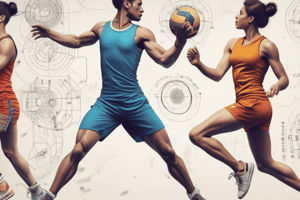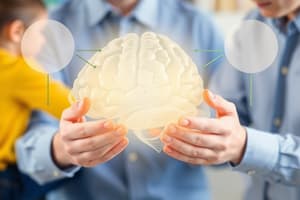Podcast
Questions and Answers
What is the definition of skill classification?
What is the definition of skill classification?
- A classification system for sports
- A learned ability to bring about predetermined results with maximum certainty (correct)
- A type of physical exercise
- A method of teaching skills
Which of the following are classifications of a motor skill? (Select all that apply)
Which of the following are classifications of a motor skill? (Select all that apply)
- Goal-oriented (correct)
- Must be learned or re-learned (correct)
- Needs a sport skill (correct)
- Involuntary
What are the three groups into which motor skills are broken down?
What are the three groups into which motor skills are broken down?
- Nonlocomotor stability, locomotor skills, manipulative skills (correct)
- Fine motor skills, gross motor skills, and complex motor skills
- Reaction time, movement time, and response time
- Balance, strength, and speed
What is the first step in the developmental taxonomy progression for kicking a ball?
What is the first step in the developmental taxonomy progression for kicking a ball?
A _____ motor skill involves very precise movements typically using smaller musculature.
A _____ motor skill involves very precise movements typically using smaller musculature.
Closed skills require a consistent _____ environment.
Closed skills require a consistent _____ environment.
What distinguishes externally paced motor skills from self-paced motor skills?
What distinguishes externally paced motor skills from self-paced motor skills?
What are the two categories of motor abilities identified by Fleischman?
What are the two categories of motor abilities identified by Fleischman?
What does the specificity hypothesis suggest about abilities?
What does the specificity hypothesis suggest about abilities?
What is the definition of reaction time?
What is the definition of reaction time?
_____ error represents variability or consistency of performance.
_____ error represents variability or consistency of performance.
What do performance outcome measures indicate?
What do performance outcome measures indicate?
Which of the following can be considered a kinematic measure?
Which of the following can be considered a kinematic measure?
Flashcards are hidden until you start studying
Study Notes
Skill Classification
- Skills involve learned abilities to achieve specific results with high certainty and minimal effort.
- Skillfulness is defined by maintaining excellence in performance most of the time.
Classifications of a Motor Skill
- Skills are goal-oriented, focusing on completing a movement to achieve a specific purpose.
- Body and limb movements are essential to accomplish sport-specific skills.
- Skills are voluntary and must be learned or relearned.
Developmental Taxonomies
- Taxonomies classify motor skills into three groups:
- Nonlocomotor stability: Maintaining body position against gravity.
- Locomotor skills: Gross motor skills primarily for body transport.
- Manipulative skills: Fine motor skills using smaller muscle groups.
- Many skills require a combination of locomotor and manipulative abilities simultaneously.
Progression for Kicking a Ball
- Kicking development progresses from stationary to dynamic scenarios, involving:
- Kicking a stationary ball into a goal while standing.
- Kicking after taking a step.
- Running and kicking a stationary ball.
- Dribbling and kicking the ball into a goal.
- Dribbling and kicking into a guarded goal.
Single-Dimensional Classifications
- Key classifications include:
- Movement precision (fine vs. gross motor skills).
- Environmental predictability (open vs. closed skills).
- Time constraints (externally vs. self-paced motor skills).
- Nature of the skill (discrete, serial, continuous).
Precision of Movement
- Fine motor skills require precise movements using smaller muscles.
- Gross motor skills involve broader movements with less emphasis on precision.
Environmental Predictability: Open Skills
- Open skills occur in dynamic, changing environments (e.g., team sports).
- Players must adapt rapidly to environmental changes.
Environmental Predictability: Closed Skills
- Closed skills are performed in predictable environments (e.g., bowling).
- Require consistent and stable conditions for execution.
Time Constraint Taxonomy
- Externally paced skills are dictated by external factors (e.g., responding to a ball).
- Self-paced skills allow the performer to initiate movements at their discretion.
Nature of Movement Organization
- Discrete skills have clear beginning and end points.
- Serial skills combine multiple discrete movements in a specific order for effectiveness.
- Continuous skills have arbitrary beginning and ending points.
Gentile's Multidimensional Classification System: Regulatory Conditions
- Regulatory conditions specify the necessary movement characteristics for skill success.
- Stability or motion of conditions affects skill execution (e.g., stationary vs. moving targets).
Gentile's Multidimensional Classification System: Action Requirements
- Analyzes whether a performer needs to change location or maintain position during a skill (body orientation).
- Considers if manipulation of an object or opponent is involved.
Abilities vs. Skills
- Abilities are genetically influenced traits that affect movement performance.
- Skills are learned through experience and practice, merging learned abilities and genetic predispositions.
Motor Ability Debate
- General motor ability posits a high correlation between overall ability and proficiency across various tasks.
- Specificity hypothesis suggests abilities operate independently.
Categorizing Motor Abilities
- Fleischman identified motor abilities predictive of high skill levels and created a two-category taxonomy:
- Perceptual motor abilities.
- Physical proficiency abilities.
Reaction Time
- Reaction time is the ability to quickly respond to a stimulus, crucial in many motor tasks.
Practical Implications of Specificity Hypotheses
- Individuals possess unique abilities shaping their skill acquisition potential.
- Engaging children in varied, developmentally appropriate movement experiences supports overall skill development.
Kinematic Measures
- Key kinematic components include displacement, velocity, and acceleration, essential for analyzing movement performance.
Timing Measures
- Movement time refers to the duration from movement initiation to completion.
- Response time combines reaction time and movement time, starting from signal onset.
Error Measurements
- Absolute error assesses distance from the target without direction consideration.
- Constant error reflects the direction and amount of deviation from a target.
- Variable error measures performance consistency and variability.
Performance Outcome Measures
- These measures indicate the results of motor skill performance, such as distance, success rate, or angles.
Performance Production Measures
- These assess specific aspects of motor control during skill execution, including force and electrical activity (EEG, EMG).
Imaging Techniques
- fMRI (functional Magnetic Resonance Imaging): Used for brain activity observation.
- EMG (Electromyography): Analyzes muscle response and action timing.
- EEG (Electroencephalography): Records electrical activity in the brain, providing insight into cognitive and motor processes.
Studying That Suits You
Use AI to generate personalized quizzes and flashcards to suit your learning preferences.




